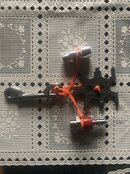- Messages
- 14,194
- Reaction score
- 11,459
- Location
- Port Orchard, Washington State
- # of dives
- 1000 - 2499
Are you bringing any deco gasses and do they have QC6s on them?I believe labeling is a bad idea. It’s best to treat QC6 gas exchanges just like a second stage gas switch. Trace the hose back to the regulator and check the MOD on the tank it’s connected too. Purge the QC6 with the tank valve closed to verify the SPG drops.
But I am not a CCR Instructor so my recommendation is worth exactly what you paid for it…..nothing. And I only run one with an in-line shut off from my right BO tank to my ADV on a sidewinder.
I only use my sidewinder in caves, the deeper BO gases which may have QC6s on them get dropped. If I did for some reason plug in my EAN50 or 100% bottles as dilout I'd figure it out pretty quick at the very latest when I tried to drop them at the MODs. There's also a number of other safeguards that make it challenging for me to plug in the wrong gas - despite the sidewinder QC6 female side being pretty unfriendly to a buddy verification.




